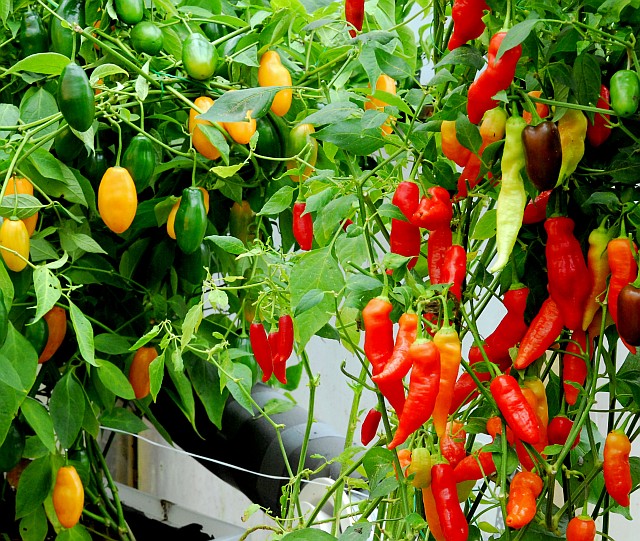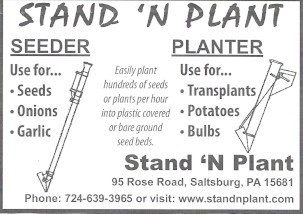
One of the advantages to growing your own produce is being able to have a fresh supply of food that would normally be more expensive when you buy it in the grocery stores. Bell peppers are one of those crops that you can use in many different recipes, but who wants to buy them at grocery store prices? Even Hatch peppers (Anaheim chilies) can be used in many dishes and sauces, especially if you like Mexican food. There’s nothing like saving money and creating great dishes from your own fresh produce. There are many different varieties of peppers and chilies. Actually chilies and peppers are the same thing, they are referred to as peppers when on the plant, and chilies when in food.
They range from sweet peppers (like bell peppers) all the way to extremely hot peppers (like habanero peppers). The heat difference is in the amount of Capsicum (Capsicum annuum) in the oil inside the peppers. Most people think the heat is in the seeds, but it’s the oils that cover the seeds. If you have ever rubbed your eyes after dicing up a pepper, you’ll know the pain was not because you rubbed a seed in your eye. Generally speaking, the smaller the pepper, the more Capsicum (and heat) it’s likely to have. When deciding on a pepper plant to grow you should pick a pepper you are familiar with and that will be useful in your dishes.
When deciding to grow peppers it’s important to consider the size of the full-grown plant, as well as the size of the root system. Peppers can be grown in a variety of hydroponics systems, though for larger plants, as well as when growing a lot of them, a drip system will probably be the most efficient.
Growing Hydroponic Peppers
Even within a species like bell peppers there are many varieties. Commercial field pepper crops are usually determinate, which means the plant only grows to a certain size producing fruit along the way, it then stops growing and eventually dies. Indeterminate varieties require constant pruning to manage their growth to optimize yield for a given space. A balance between vegetative (leaves and stems) and fruit growth should be established and maintained. Indeterminate varieties don’t stop growing, they grow much the same way as tomato plants do. These types are usually grown in greenhouses and trained to grow upwards on a supporting trellis. The crop grows taller which maximizes space and increases productivity for the crop.
Whatever type of pepper plants that you grow it’s important to consider the spacing. Spacing them close together can help maximize yield, but they can’t be so close that they are crowded. Pruning improves air circulation around the plant which helps to reduce disease. Indeterminate varieties will need to be continually pruned (about every two weeks), because they continually grow new stems and leaves. Greenhouses usually keep them to 2 main stems growing upward from each plant. Indeterminate varieties can grow to a height of up to 4 meters (13 feet) and will need to be supported. They are usually trained to grow on trellises made of twine. The twine is hung from the overhead support wires and is used to support each stem. Make sure that the twine is not tied too tight to the stem, or the stem can be damaged when it expands as it continues to grow.
Flowering and Fruit Set
Though there are many varieties of pepper plants, they are generally a warm weather plant. Flowering and fruit set, as well as fruit size, are all related to temperature and fluctuations in the day/nighttime temperature. The optimum temperature for flowering and fruit set in sweet bell peppers is 65-70 F°, while the optimum 24-hour temperature (24-hour average temperature) for yield is 70-75 F°. Unlike tomatoes, pollination of the pepper flowers occurs successfully without any outside pollination assistance from bees (in the correct temperature range), although additional pollination assistance from bees or other pollinating insects, as well as hand pollination has shown to improve flower set, and eventual yield and quality of the pepper fruit.
Deformed fruit is usually caused by inadequate pollination. This inadequate pollination can be a result of temperature, but it can also be caused by the light intensity being too strong. The fruit themselves should be shaded adequately, either by the leaves or shade cloth for best results. However, the plants generally do not have trouble continuing to set flowers in less-than-ideal conditions. The root zone temperature is important also, if the root zone becomes too warm (above 72-75 degrees F°) the plants will tend to abort setting fruit and the flowers will drop off.
Even if the fruit is not perfect in shape and size, it will still taste good and will be just fine in your dishes. People are used to seeing perfectly shaped fruits and vegetables at the market, but remember that not everything grows perfect in nature. The produce you don’t see at the market gets sold to companies that use them in other prepared foods. Do you know what the shape of that pepper was that’s in your pre-made salsa, or before they made the hot sauce with them?
Jeff Sanders runs a hydroponics website call HomeHydroSystems.com to help hydroponics enthusiast learn how to build their own hydroponic systems, as well as learn about many topics related to hydroponics so they can grow to their own crops successfully.
Related Articles & Free Email Newsletter
Choosing the Best Hydroponic System for Your Greenhouse
Curious About CBD? Here’s What it Can and Cannot Do for You
Popular and Easy Hydroponic Plants




Comment here